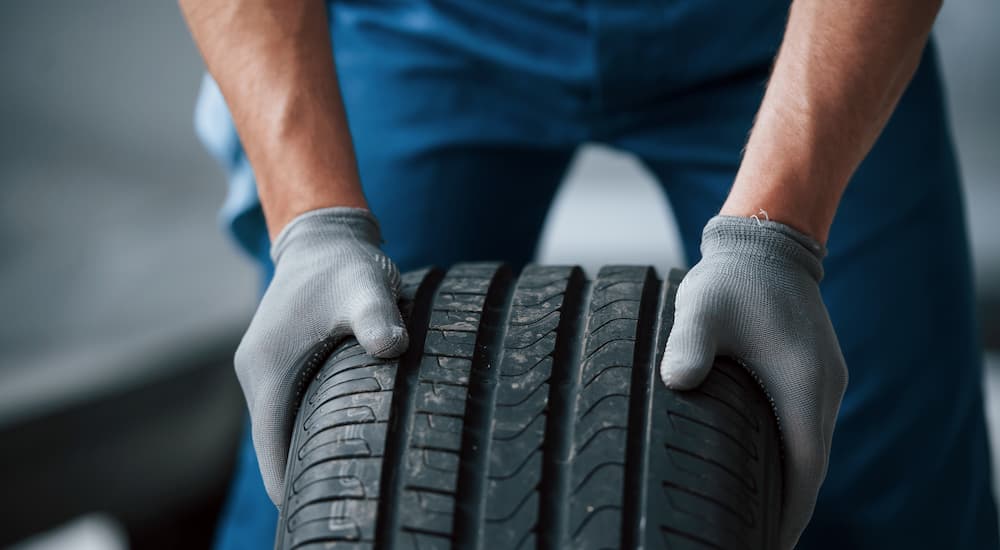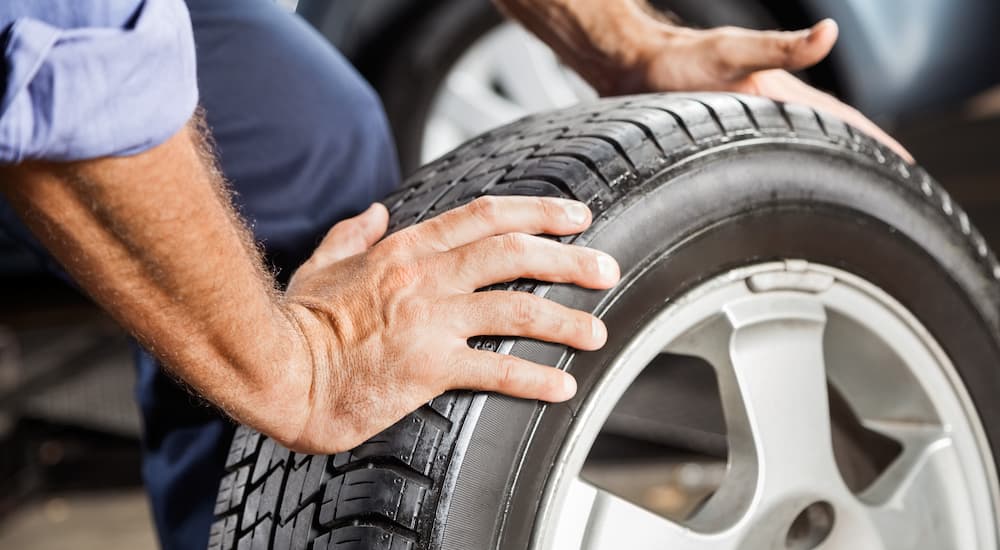While a well-maintained car, truck, or SUV can stay on the roads for years, if not decades, the same cannot be said of its tires. No matter how much TLC you might give your Honda tires––going easy on the pedals, following the proper rotation schedule, and keeping them at the ideal PSI––sooner or later, they’re going to wear out, and you’ll find yourself shopping for a new set. But how’s a driver to know when it’s time to swap their old, worn-out tires?
There are plenty of ways to determine how much life a tire has left in it, from a visual inspection to signs and symptoms that may begin to crop up when you’re behind the wheel. These warning signs should always be heeded at a driver’s earliest convenience since the alternative––like waiting until you experience a blow-out on a busy highway or dramatic loss of traction in the next big snowstorm––aren’t very fun to contemplate. Below we’ve rounded up a few tips for measuring your tire’s remaining tread life that should make it easy to know when it’s time to invest in a new set and included a few pointers when it comes to getting the most out of your tires.
How Often Should They Be Replaced?
When it comes to a timetable for replacing tires, experts generally recommend swapping out for a completely new set every six years. This might sound a little overanxious since most of today’s tires are rated to last ten years, but that’s an outside estimate and not a number you want to be relying on when it comes to your safety. As a tire’s tread begins to wear out, drivers can see a dramatic loss in traction, which not only impacts a vehicle’s driving dynamics, turning, and ability to navigate slippery surfaces, but can also have a noticeable effect on fuel efficiency.
How do you know when you last had your tires replaced? Keeping a log of your vehicle’s service records can be very helpful when it comes to tracking your vehicle’s performance over time or knowing when it’s time to replace parts, and it comes in very handy should you ever decide to sell your vehicle. However, if organization isn’t your strong suit, you’re in luck because tire manufacturers have a handy way to date your tires without resorting to the old paper trail.
Every tire sold today includes a four-digit code located on the wall of the tire itself. The sidewall of a modern tire might be filled with strange letters, symbols, and numbers that make hieroglyphics look simple in comparison, but the tire’s manufacture date should be pretty easy to spot. It’s often preceded by the letters DOT for Department of Transportation, with the acronym indicating that the tire complies with the U.S. Department of Transportation’s safety standards. This four-digit number is actually the date the tire was manufactured, with the first two numbers representing the week it was made and the second two standing in for the year. For example, a tire with a date like 3619 stamped into the sidewall was produced in the 36th week of the year 2019, which would be sometime in late August. A tire stamped 3619 is technically rated until late summer 2029, but realistically, it should be replaced about four years earlier, in the summer of 2025.
Of course, the tire’s manufacture date isn’t the only way to tell how many miles your tires might have left in them. All tires are sold with a Uniform Tire Quality Grading (UTQG) stamped into the tire and preceded by the word Treadwear and followed by ratings for Traction and Temperature (which we won’t get into here). This handy three-digit number indicates how many miles a tire should last under normal conditions, with a higher number indicating a tire with more longevity. UTQG spans from 200 or less on the low end to 600 or greater at the upper reaches, though most tires fall in the 300 to 400 range. A tire with a UTQG of 350, for instance, can be expected to perform for around 55,000 to 58,000 miles, though it never hurts to go with the lower figure for the sake of safety. Tires rated 200 on the UTQG scale will only last around 20,000 miles, while a 600-rated tire can perform for up to 80,000 miles.
Again, going by the UTQG method requires a little pre-planning on the part of the driver, who needs to have at least a rough idea of what the overall mileage was when the tires were first installed. Next time you visit your local tire shop to swap out your treads, make sure to note the mileage on the receipt or any paperwork you might receive. Most tire retailers will note your mileage as a matter of course, but it never hurts to scribble down a reminder just in case.

How Can You Tell When They Need to be Replaced?
Metrics such as tire age and UTQG can be a handy, if slightly academic, way to gauge how much life in left in a tire, but more often than not, it’s going to be visual and performance cues that let you know when it’s time to make your next appointment at the tire shop or dealership.
Tread Wear Bars
Tires include a handy system for being able to tell, at a glance, when it’s time for a replacement. Known as tread wear bars, these are basically raised bridges set into the deepest part of a tire’s tread that run perpendicular to the grooves of the tread itself. As a tire’s tread wears down over time, these tread wear bars will become more and more visible until, eventually, they’re flush with the tread. Ideally, you should replace your tires before they reach this point, as it means there’s only around 2/32 of an inch of tread remaining, which can be dangerous.
Tread Depth Indicator
If you’re looking for a more accurate reading of remaining tread depth, consider investing in a tread depth indicator. Available for as little as $4, these handy little tools allow you to get a precise tread depth reading using a system that’s a little more scientific than the tread wear bar approach. Simply place the probe in various parts of the tire’s grooves spaced at least 15 inches apart, then average the figures together to get an overall tread depth for the tire as a whole. Again, the magic number here is 2/32 of an inch, so if your calculations come out any lower, it’s time for new tires.
The Penny Test
If you don’t want to go out and buy a tool, we’ve got a classic standby that costs all of one cent. Take an average U.S. penny and place it upside down in the groove of the tire with old Abraham Lincoln’s head facing towards you. If you can see the top of Honest Abe’s head or the copper above it, your tire is working with less than the recommended 2/32 of an inch of remaining tread depth. It might lack the accuracy of the tread depth indicator or ease of consulting the tread wear bar, but it’s a reading you can trust. If results are inconclusive, repeat this process at various points around the tire since an overinflated tire might wear out more quickly towards the center while an underinflated tire will do the opposite.
Remember that 2/32 of an inch is the legal minimum tread depth in the U.S. While this is the legal minimum, industry experts generally advise drivers to replace a tire when the tread depth is at 4/32 of an inch, twice the legal minimum, for safety reasons. Around a half-dozen states have no minimum tread depth requirements, but that still doesn’t mean that it’s a good idea to ignore the warning signs. According to a study by Consumer Reports, a tire with half of its tread remaining loses almost 15 percent of its traction in snowy and icy conditions. The likelihood of hydroplaning also decreases by around eight percent while stopping distance in wet conditions increases by three to six feet.
Tips for Extending Tire Life
Now that you know some of the warning signs of worn-out tires, the question is: how do you make them last as long as possible? No matter how much you baby them, your tires aren’t going to last forever, but there are a few simple tips for making sure they give you the most bang for your buck. These include:
Taking It Easy
Putting the pedal to the metal, whether it be the gas or brake, is a great way to wear out your tires well before their time. Taking a more measured, gradual approach to pressing the gas or brake will allow your tires to wear more evenly and can go a long way in extending their service life. The same is true of steering, especially at higher speeds, so take it easy unless you just really happen to like the coffee they serve in the tire shop waiting room.
Minding Your Tire Pressure
Following the recommended pressure guidelines for your specific set of tires can make all the difference when it comes to tread life. Low pressure can cause tires to wear out prematurely in the center, while higher pressure will take its toll on the tire’s outside edges. Check your tire pressure monthly to make sure it falls within the specified range, and note that temperature and time can both cause fluctuations in tire pressure. A typical tire will lose around one PSI a month. Cold temperatures will also lead to lower tire pressure, while higher temps can actually see it increase.

Rotating and Aligning
Regular tire rotation and alignment are both great ways to head off uneven wear patterns before they can take hold and prematurely age your tires. Tire rotation should be performed every 5,000 to 8,000 miles, and alignments follow largely the same schedule. Tire rotation involves switching the tires to a new position, while alignment means adjusting the angle of the wheels to ensure they’re following a straight path. Tire rotation is particularly important as improperly rotated tires can have less than half the usable service life of a well-rotated set.
Choosing the Right Tires
If you’re looking for the maximum return on investment, the right set of tires can make all the difference. Believe it or not, not all tires are made to last, with some drivers valuing certain performance characteristics over longevity. If you’re looking for a set that will serve you for the long haul, look for tires with the best possible tread life warranty and a high UTQG rating.
Make Your Tires Last
With a little planning and some attention to detail, it’s easy to squeeze a few extra miles out of your tires. Shopping around for tires with a high UTQG is a good start but just remember, no matter how many miles your tires are rated for, they shouldn’t be expected to last longer than six years, regardless of use. After that period, the compounds within the tires will be past their prime and are more prone to the sort of wear and damage that can easily result in that dreaded roadside assistance call.
Keep an eye on your tread depth, and when in doubt, use any of the methods described above to judge just how much life your tires have left in them. It’s a cheap and simple test that costs anywhere from one cent to $4, so there’s little excuse for letting it slip by the wayside. Proper alignment, rotation, good driving habits, and selecting the right tires are all important factors when it comes to extending your tire’s service life and could go a long way in preventing more dangerous and expensive incidents down the road.

